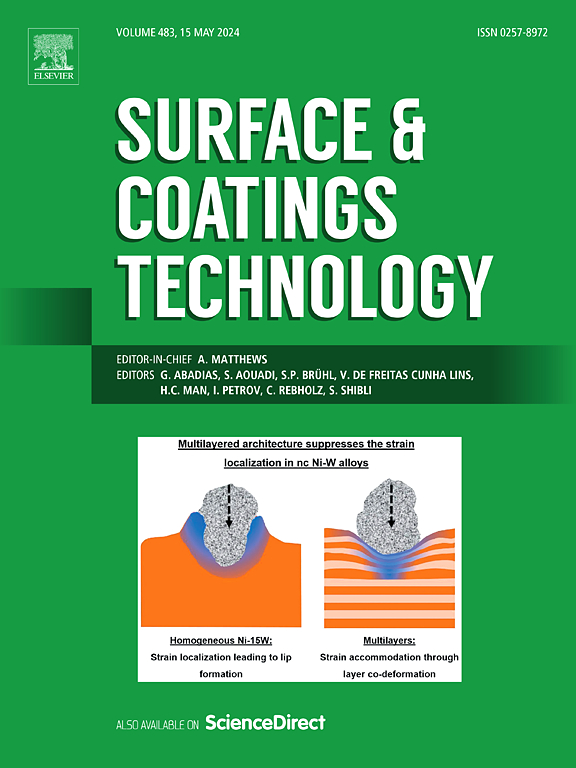The microstructure evolution and performance enhancement mechanism of a novel laser cladding 20CrNiMoBSiY high-temperature alloy with high wear and corrosion resistance
IF 5.3
2区 材料科学
Q1 MATERIALS SCIENCE, COATINGS & FILMS
引用次数: 0
Abstract
Wear-resistant and corrosion-resistant Fe-based high-temperature alloys have great potential in laser additive manufacturing of metallurgical high-temperature friction parts. However, due to the operational temperature range of 400–800 °C, the friction parts of traditional Fe-based high-temperature alloys often exhibit issues such as poor laser formability and unstable high-temperature performance, primarily caused by cladding cracks and porosity defects. This study utilized thermodynamic phase diagram calculations to simulate the hardness and pitting resistance equivalent number (PREN) of Fe-based alloys, optimizing and designing a novel 20CrNiMoBSiY high-temperature alloy with high wear and corrosion resistance. The alloy powders were prepared using vacuum induction gas atomization (VIGA), and the formability, microstructure evolution and performance enhancement mechanism of laser cladded alloy samples were investigated. The results indicate that the optimized composition of the alloy is 20Cr17Ni2Mo2B1.1SiY. The alloy powder has a spherical shape, uniform composition, smooth surface and flowability of 16 s/50 g. The microstructure of the cladded alloy samples primarily comprises M, retained austenite, (Fe,Cr)2(B,C), (Cr,Fe)23(C,B)6, and (Cr,Fe)7(C,B)3. These phases not only exhibit excellent formability but also possess high hardness, corrosion resistance, and superior high-temperature wear resistance. When the laser energy density is optimized to 138 J/mm3, the hardness of the cladding sample reaches 622 HV0.2, the minimum corrosion current density is 5.72 × 10−6 A·cm−2. At 800 °C, the wear rate is 42 % lower than that of the Q235 steel. The mechanism of synergistic enhancement performance of multiphase microstructure evolution in laser cladding alloys was finely clarified. A novel laser cladding 20Cr17Ni2Mo2B1.1SiY high-temperature Fe-based alloy with high wear resistance and corrosion resistance has been obtained. This work provides valuable reference for laser cladding remanufacturing of metallurgical high-temperature friction parts.
激光熔覆20CrNiMoBSiY高耐磨耐蚀高温合金的组织演变及性能增强机制
耐磨损、耐腐蚀的铁基高温合金在冶金高温摩擦件激光增材制造中具有很大的应用潜力。然而,由于传统铁基高温合金的工作温度范围为400-800℃,摩擦部件往往存在激光成形性差、高温性能不稳定等问题,主要是由熔覆裂纹和气孔缺陷引起的。本研究利用热力学相图计算模拟了铁基合金的硬度和耐点蚀等效数(PREN),优化设计了一种新型20CrNiMoBSiY耐磨损耐腐蚀高温合金。采用真空感应气体雾化法制备合金粉末,研究激光熔覆合金样品的成形性能、显微组织演变及性能增强机理。结果表明,合金的最佳成分为20Cr17Ni2Mo2B1.1SiY。合金粉末呈球形,成分均匀,表面光滑,流动性为16 s/50 g。包覆合金试样的显微组织主要有M、残余奥氏体、(Fe,Cr)2(B,C)、(Cr,Fe)23(C,B)6和(Cr,Fe)7(C,B)3。这些相不仅具有优异的成形性,而且具有高硬度、耐腐蚀性和优异的高温耐磨性。当激光能量密度优化为138 J/mm3时,熔覆样品的硬度达到622 HV0.2,最小腐蚀电流密度为5.72 × 10−6 A·cm−2。在800℃时,磨损率比Q235钢低42%。进一步阐明了激光熔覆合金多相组织演化协同增强性能的机理。获得了一种新型激光熔覆20Cr17Ni2Mo2B1.1SiY高温铁基合金,具有较高的耐磨性和耐腐蚀性。为冶金高温摩擦件激光熔覆再制造提供了有价值的参考。
本文章由计算机程序翻译,如有差异,请以英文原文为准。
求助全文
约1分钟内获得全文
求助全文
来源期刊

Surface & Coatings Technology
工程技术-材料科学:膜
CiteScore
10.00
自引率
11.10%
发文量
921
审稿时长
19 days
期刊介绍:
Surface and Coatings Technology is an international archival journal publishing scientific papers on significant developments in surface and interface engineering to modify and improve the surface properties of materials for protection in demanding contact conditions or aggressive environments, or for enhanced functional performance. Contributions range from original scientific articles concerned with fundamental and applied aspects of research or direct applications of metallic, inorganic, organic and composite coatings, to invited reviews of current technology in specific areas. Papers submitted to this journal are expected to be in line with the following aspects in processes, and properties/performance:
A. Processes: Physical and chemical vapour deposition techniques, thermal and plasma spraying, surface modification by directed energy techniques such as ion, electron and laser beams, thermo-chemical treatment, wet chemical and electrochemical processes such as plating, sol-gel coating, anodization, plasma electrolytic oxidation, etc., but excluding painting.
B. Properties/performance: friction performance, wear resistance (e.g., abrasion, erosion, fretting, etc), corrosion and oxidation resistance, thermal protection, diffusion resistance, hydrophilicity/hydrophobicity, and properties relevant to smart materials behaviour and enhanced multifunctional performance for environmental, energy and medical applications, but excluding device aspects.
 求助内容:
求助内容: 应助结果提醒方式:
应助结果提醒方式:


